You rely on antibacterial surfaces to maintain a sterile environment. But this protection can fade without warning, creating a hidden risk of contamination in critical care areas.
Yes, antibacterial coatings can lose effectiveness over time. This degradation is caused by physical abrasion, frequent cleaning with harsh chemical disinfectants, and prolonged exposure to environmental factors like UV light. Their longevity depends on the coating’s quality and the specific usage conditions.
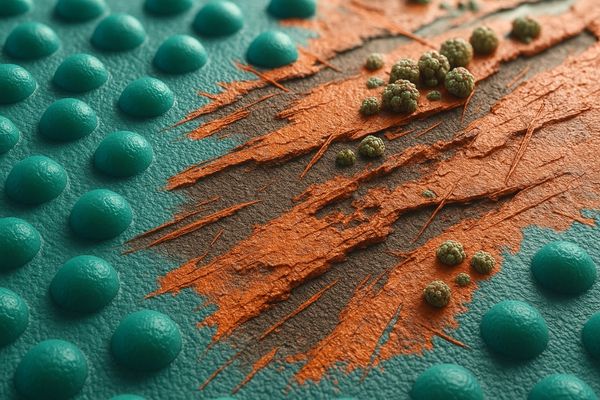
Modern medical equipment increasingly features specialized surfaces designed to inhibit microbial growth1. These coatings represent a critical line of defense in hospital infection control protocols2. However, their durability is not infinite, and their performance can diminish over the course of a product’s life. It is important for clinical and procurement professionals to understand how these surfaces age. We must also know what factors contribute to their degradation. This knowledge allows us to make informed decisions and ensure that our equipment remains safe and effective for its entire operational lifespan.
What factors cause antibacterial coatings to degrade in medical environments?
You assume a monitor’s antibacterial housing provides constant protection. But daily wear and tear silently chip away at this defense. The surface may no longer be as safe as you believe.
The primary factors are physical abrasion from contact and handling, chemical degradation from harsh cleaning agents, and environmental exposure to UV light. Over time, these elements can physically remove the coating or neutralize its active antibacterial agents, reducing its effectiveness.
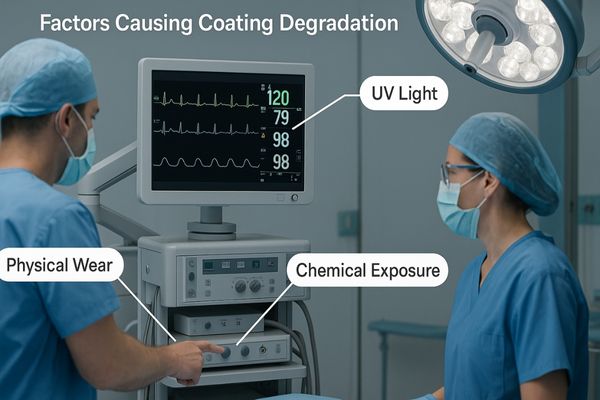
The effectiveness of an antibacterial coating3 is subject to a constant assault in a busy medical environment. The first major factor is physical wear. This includes abrasion from repeated touching by gloved hands, contact with other pieces of equipment, and the friction from daily wiping and cleaning. Over time, this mechanical action can physically wear away the thin top layer of the coating where the antibacterial agents are most active. The second factor is chemical degradation4. Medical facilities use potent disinfectants to maintain sterility. These chemicals, while necessary, can be harsh on surfaces. Certain agents can slowly break down the polymer matrix that holds the coating together, causing it to become brittle or leach out its active ingredients. Finally, environmental factors like UV light, whether from sunlight or specialized sterilization lamps, can degrade the chemical structure of the coating. Together, these factors create a cumulative effect that slowly diminishes the surface’s ability to inhibit microbial growth. Our MS321PB 32" 4K Surgical Monitor is designed with a robust housing to withstand these challenges in demanding surgical settings.
How often should medical displays with antibacterial coatings be tested for efficacy?
You follow a strict cleaning schedule. But you have no way of knowing if the antibacterial surface is still working. This uncertainty undermines your hospital’s infection control efforts.
There is no universal mandated schedule. Testing frequency should be based on the manufacturer’s guidelines, the hospital’s internal risk assessment, and the intensity of use. For high-contact areas, periodic verification as part of a comprehensive hygiene audit is a best practice.
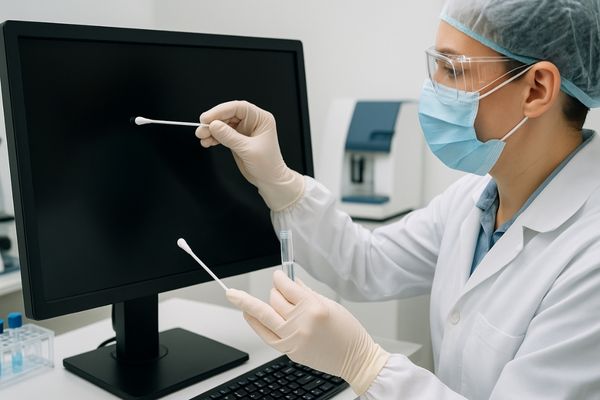
Determining the ideal testing frequency for antibacterial efficacy is a complex issue without a one-size-fits-all answer. It is not practical for hospitals to perform constant microbiological tests on every surface. Instead, the approach should be based on a combination of manufacturer validation and internal hospital protocols. As manufacturers, we perform extensive durability testing to simulate years of use before a product is ever released. This provides a baseline for expected performance. From the hospital’s side, the best practice is to incorporate surface checks into a larger, risk-based hygiene program5. For example, a high-touch surgical display in an operating room may warrant more frequent attention than a diagnostic monitor in a radiologist’s office. Methods like Adenosine Triphosphate (ATP) bioluminescence testing6 can be used during regular audits. While ATP tests measure general organic residue rather than specific bacteria, consistently low readings can indicate that the surface is clean and its protective features are intact. Our MD26GA 2MP Diagnostic Monitor, for instance, is built for durability, but we still advise integrating its care into the facility’s overall hygiene monitoring plan.
Do cleaning agents and disinfectants affect the longevity of antibacterial surfaces?
You use powerful disinfectants to ensure every surface is sterile. But these same chemicals could be destroying the very antibacterial coatings designed to help. This creates a difficult paradox.
Yes, they have a significant impact. Harsh, abrasive, or highly concentrated chemical agents, particularly those containing high levels of alcohol, chlorine, or peroxide, can accelerate the degradation of the coating, reducing its antibacterial effectiveness and lifespan.
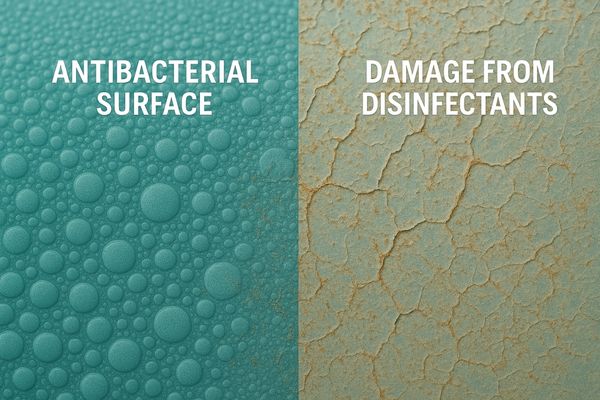
The relationship between disinfectants and antibacterial coatings7 is a delicate balance. A disinfectant’s job is to kill microbes on contact, while the coating’s job is to provide continuous, passive protection. Unfortunately, the powerful chemicals needed for immediate disinfection can harm the long-term integrity of the coating. For example, high-concentration alcohol can dry out the polymer that binds the coating, leading to micro-cracks. Bleach-based solutions containing sodium hypochlorite can chemically oxidize and neutralize the silver ions or other active agents embedded in the surface. This is why it is absolutely critical to follow the manufacturer’s cleaning recommendations. We specify which types of disinfectants8 and what concentrations are compatible with our surfaces. Using an unapproved chemical or a concentration that is too high may achieve short-term sterility at the cost of long-term protection. The goal is to use a disinfectant that is effective against pathogens but gentle enough not to compromise the equipment’s engineered surfaces. This is especially true for devices like our MS192SA 19" HD Endoscopic Monitor, which is cleaned frequently between procedures.
Disinfectant Impact on Antibacterial Coatings
| Disinfectant Type | Active Ingredient | Potential Impact on Coating |
|---|---|---|
| Quaternary Ammonium | Benzalkonium Chloride | Low (Generally safe and recommended) |
| Isopropyl Alcohol | 70% Alcohol | Medium (Can cause drying with prolonged use) |
| Accelerated Hydrogen Peroxide | Hydrogen Peroxide | Medium (Can be aggressive on some polymers) |
| Sodium Hypochlorite | Chlorine (Bleach) | High (Can cause oxidation and degradation) |
Are there industry standards that define acceptable performance over time for antibacterial coatings?
You need to source equipment that meets clear safety standards. But when it comes to coating longevity, the rules are unclear. This makes it difficult to compare products confidently.
Specific standards for long-term antibacterial performance are still emerging. While standards like ISO 22196 measure initial efficacy, there is no universal benchmark for durability over time. Reputable manufacturers rely on internal, rigorous long-term simulation testing to validate lifespan.
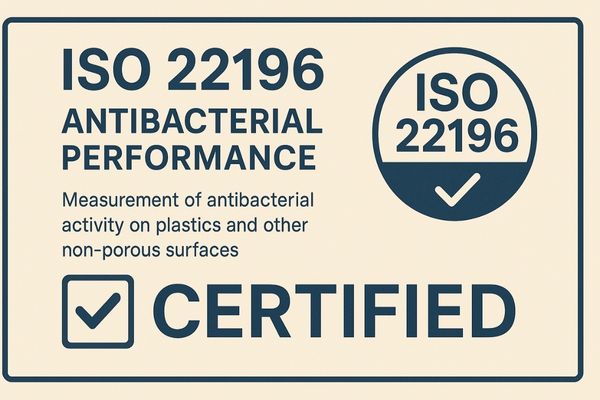
The standardization landscape for antibacterial coating longevity is still developing. There are well-established standards, such as ISO 221969 and JIS Z 2801, that provide a reliable method for measuring the antibacterial activity of a new, untouched surface. These tests are invaluable for verifying a product’s initial efficacy. However, they do not address the critical question of how that performance holds up after months or years of use in a real-world clinical setting. Currently, there is no universally accepted industry standard that defines "acceptable performance over time." This leaves a gap for buyers, who must rely on the manufacturer’s own data and validation processes. General medical device regulations from bodies like the FDA or under the European MDR require that a device remains safe and effective for its stated lifetime. This indirectly covers surface integrity, but it does not provide a specific, measurable benchmark for coating durability10. This is why we believe it is our responsibility to go beyond the basic standards and conduct our own extensive, long-term testing. The reliability of critical devices like our MD33G 3MP Grayscale Diagnostic Monitor depends on this commitment.
Key Antibacterial Testing Standards
| Standard | What It Measures | Key Limitation for Longevity |
|---|---|---|
| ISO 22196 | Measurement of antibacterial activity on plastic and non-porous surfaces. | Tests a new surface; does not account for wear, cleaning, or aging. |
| JIS Z 2801 | Japanese Industrial Standard, precursor to ISO 22196. | Same as ISO 22196; measures initial efficacy only. |
| ASTM E2180 | Standard test method for determining the activity of incorporated antimicrobial agent(s) in polymeric materials. | Measures the presence of the agent, but not always its real-world effectiveness after aging. |
How does Reshin ensure that their antibacterial coatings remain effective throughout the product lifespan?
You need to trust that your equipment’s safety features will last. But how can you be sure of a manufacturer’s claims about durability? Without proof, it is just a marketing promise.
We use a multi-faceted approach combining durable coating materials with rigorous, accelerated aging tests. We simulate thousands of cleaning cycles with hospital-grade disinfectants and perform microbiological tests on the aged surfaces to verify sustained antibacterial performance.
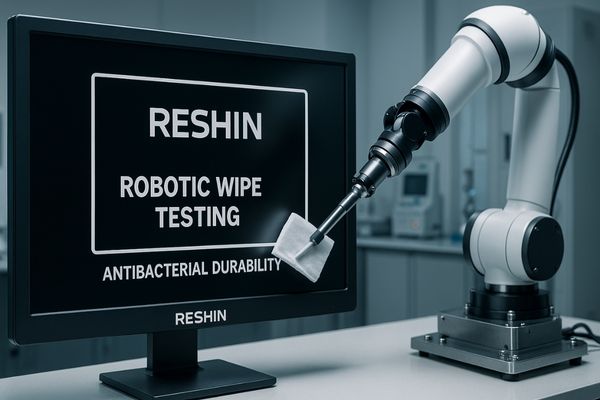
We understand that a claim of "antibacterial" is meaningless if it does not last. To ensure our coatings remain effective, we have developed a comprehensive validation process that goes far beyond standard tests. It begins with material science, where we select advanced coating formulations known for their inherent durability and chemical resistance. Then, we subject our products to a series of accelerated aging protocols in our quality assurance labs. We use automated robotic arms to perform thousands of wipe cycles on the monitor housings, using the very same hospital-grade disinfectants that our customers use. This process simulates years of intensive, daily cleaning. After the aging process is complete, we do not just look for visible wear. We take samples from these artificially aged surfaces and conduct the same rigorous microbiological tests (based on the ISO 22196 standard11) that we perform on new products. This allows us to quantify the remaining antibacterial efficacy12 and confirm that it still meets our high performance standards. This commitment to proven longevity is built into every product we make, including our MS270P 27" FHD Surgical Display.
Conclusion
Antibacterial coatings are a valuable safety feature, but their effectiveness can degrade. Understanding the factors causing this decline and choosing products from manufacturers committed to rigorous lifespan testing is crucial. To explore medical displays with advanced, tested antibacterial coatings, contact Reshin at martin@reshinmonitors.com.
-
Exploring this topic reveals innovative solutions that enhance patient safety and equipment longevity. ↩
-
Understanding these protocols is essential for maintaining safety in healthcare settings and preventing infections. ↩
-
Explore this link to understand how antibacterial coatings enhance hygiene and safety in healthcare settings. ↩
-
Learn about the impact of chemical degradation on medical equipment to ensure longevity and effectiveness. ↩
-
Discover the benefits of a risk-based hygiene program to optimize cleaning efforts and maintain high standards in healthcare settings. ↩
-
Explore this link to understand how ATP testing can enhance hygiene protocols and ensure effective surface cleanliness. ↩
-
Exploring antibacterial coatings can reveal their advantages in providing continuous protection against harmful microbes. ↩
-
Understanding best practices for disinfectants can help maintain surface integrity while ensuring effective microbial control. ↩
-
Understanding ISO 22196 is crucial for evaluating antibacterial coatings’ effectiveness and longevity in real-world applications. ↩
-
Exploring coating durability helps ensure the safety and effectiveness of medical devices over time, which is vital for patient care. ↩
-
The ISO 22196 standard is essential for ensuring product safety and effectiveness. Discover its details to enhance your knowledge. ↩
-
Understanding antibacterial efficacy is crucial for evaluating product effectiveness. Explore this link to learn more about its significance. ↩


